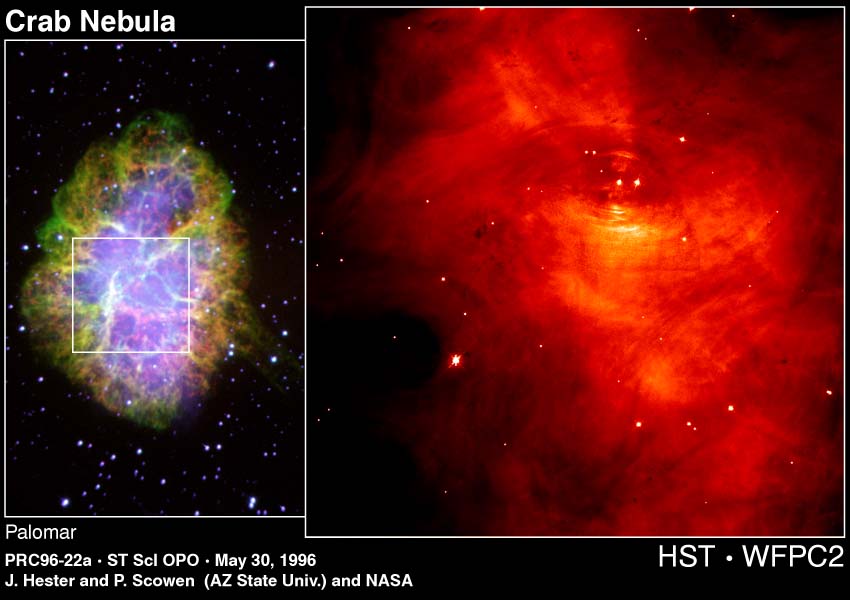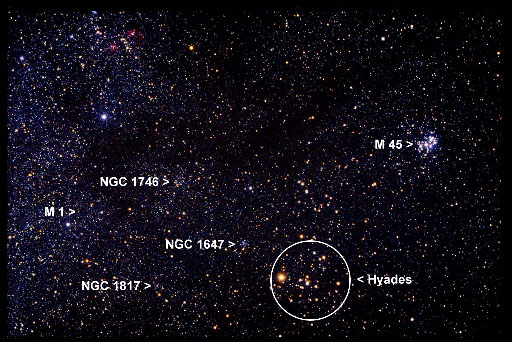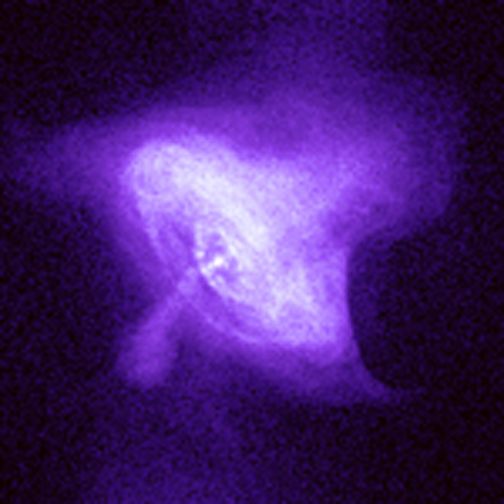
This object, M1 in the Messier catalog of night-sky diffuse astronomical figures, resulted from a supernova explosion within our galaxy in 1054 A.D. At present it consists of a still-bright network of rapidly expanding filaments (somewhat Crab-like in appearance, hence the name), plus a most remarkable object: the Crab pulsar, the remnant of the exploded star, which is spinning at an astonishing 2400 RPM. The Sun, by contrast, is rotating 100 million times slower! We show some pretty pictures below, and note that you can easily find many Web pages with more background information in this wonderful world of information. These came from Mt. Palomar and from the Hubble Space Telescope.

On the left, you see the nebular synchrotron emission (appropriately blue) plus the filaments; on the right you can spot the pulsar (one of the two comparable stars just above center). If you would like to locate this in the sky, here's a sky map of the constellation Taurus, which turns out to contain the Pleiades (and the Hyades, as marked): The location marked M1 is the Crab Nebula. It's hard to believe that Messier could actually see it without a telescope, but he must have!

What, you ask, does this have to do with Yohkoh and the Sun? Two things. First, scientifically, we're seeing something that is allied to the physics we're familiar with: never mind that the Sun does not contain a dizzily spinning neutron star, nevertheless it too can eject matter and accelerate particles. In fact, much of what we do in studying flares and coronal mass ejections has to do with understanding just this kind of physics. So we are not far off base.
Second, by a cosmic coincidence, the ecliptic plane (the path the Sun appears to move along through the year) goes right through Taurus. The Crab Nebula, on June 14, comes with 1.2 degrees of the Sun. So a solar-viewing satellite can relatively easily swing over to take a peek.
Based on the above, you've guessed that Yohkoh's hard X-ray telescope observed the Crab Nebula on June 14. In principle, this is an excellent science opportunity, since HXT is the highest-resolution hard X-ray telescope in space until HESSI is launched; HESSI will make its first Crab observation in June 2001 for the same astronomical reason. We're all inspired to do this because of the wonderful Chandra X-ray image of the Crab and its pulsar:

In the Chandra soft X-ray image above one can actually see evidence for the rotational motion leading to the accretion disk theorized to be feeding the pulsar, and the jets coming from its poles. Quite amazing.
For the first time in its almost nine years of life, Yohkoh has therefore deliberately pointed far, far (1.2 degrees, further than we can see a CME, of course) from Sun center. This took an entire day out of Yohkoh's solar observations, but of course it will be worth it scientifically if the Crab observations succeed. This happened during the "invisible orbits" between 10:18 UT June 14, and 08:45 UT June 15, and Yohkoh has now successfully returned to solar observations. After the observation it will be a long, hard analysis chore, we think, to generate an actual hard X-ray map, so please stay tuned for another Crab nugget in a year or so.
First, let us assess the expected results. We know the total spectrum quite well (see Zombeck, for example). The spectrum (nebula plus pulsar, the latter a 10-20% component) very nearly has the convenient form J = 10*E-2 ph/cm2-sec-keV which we can use to estimate what HXT will see. In the best energy band for HXT, 23-33 keV, we estimate an efficiency of about 80% over an effective area of 6.25 cm2, do the integral, and find 0.28 counts/sec per subcollimator (HXT has 64). Not bad! The background rate is about 2.5 counts/sec, so the Crab signal is on the order of 10% of the background. This means that we can't easily see the signal directly, but that we can integrate - if we integrate for 20,000 sec, we find a total number of signal counts of 2800 in each subcollimator. The fluctuation in the background should be on the order of sqrt(50000) = 224. Thus S/B is about .11, but S/N after a long integration may be about 12. Pretty good!
12 June 2000
Hugh Hudson (hudson@isass1.solar.isas.ac.jp)